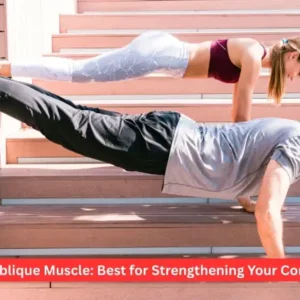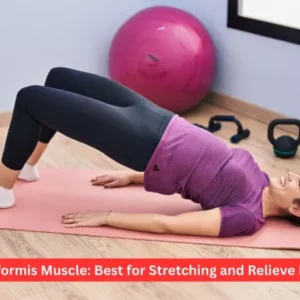Proprioceptive neuromuscular facilitation (PNF) is a stretching technique that can help you gain range of motion. Many therapists utilize PNF stretching to assist patients in restoring range of motion following an injury or surgery, but athletes can also use it to increase their flexibility.
PNF can help you improve your muscles, but it’s risky if you’re not a pro athlete. Continue reading to learn how PNF stretching works.
- What is PNF(Proprioceptive Neuromuscular Facilitation) Stretching? (Defination)
- How does it work? (Theoretical Mechanisms)
- What are the benefits of PNF stretching?
- What are the different Methods to perform PNF Stretching?
- What are the best Tips and techniques for PNF stretching
- Is PNF stretching safe?
- Bottom Summary
- FAQ’s
What is PNF(Proprioceptive Neuromuscular Facilitation) Stretching? (Defination)
PNF stretching is a technique used to increase muscle flexibility. It can improve both your active range of motion (the space in which you can move a part of your body with your muscles) and your passive range of motion (the area in which a part of your body can move when someone or something is causing the movement, such as someone pulling on your arm) (Hindle, 2012).
PNF stretching is commonly employed by physical therapists and professional exercise trainers in athletic or rehabilitation contexts. This strategy can assist you in (Hindle, 2012):
- Improve performance
- Rehabilitate injuries
- Restore range of motion
- Increase strength
It is frequently used for persons who have sustained soft tissue injuries or undergone invasive surgery (Hindle, 2012).
PNF stretching techniques include static stretches (stretches that do not move) and isometric contractions (contracting a specific muscle without moving the joint). These techniques are often regarded as highly effective, yet surprisingly little research has been conducted to investigate their effects (Behm, 2016).
All stretching methods have been found to improve flexibility and range of motion. However, sports medicine researchers are still unsure whether this type of stretching is the most effective. Many studies only measured flexibility for a short period after stretching, such as 10 minutes, making it difficult to evaluate different forms of stretching (Behm, 2016).
How does it work? (Theoretical Mechanisms)
Okay, this gets a little heavy. I’ll do my best to summarise it without losing you along the way. If this interests you, please examine some of the references below, as this will be a very short description. Also, if this does not interest you, feel free to skip ahead to how to conduct a PNF technique; I will not object.
Four potential physiological pathways contribute to PNF-enhancing ROM. These include autogenic inhibition, reciprocal inhibition, stress relaxation, and gate control theory.
Autogenic inhibition
Autogenic inhibition occurs when a tensed or stretched muscle’s excitability decreases due to inhibitory signals transmitted from the muscle’s Golgi tendon organs (GTOs). It is a muscular reaction that causes rapid relaxation when significant tension develops. It is a self-induced, inhibitory, adverse feedback-lengthening reaction that prevents muscle injury.
Reciprocal inhibition
Reciprocal inhibition explains how muscles on one side of a joint relax to allow contraction on the other.
Relaxing from stress
Stress relaxation occurs when the musculotendinous unit (MTU) experiences consistent stress throughout time at a set length. This reduces the force created by the viscous material as it resists the elongation stimulus caused by stretching within the MTU. Because the viscous material loses its ability to resist stretching over time, the MTU gradually grows in length (Sharman et al., 2006).
Gate Control Theory
According to the gate control theory of pain, pain signals do not reach the brain as soon as they are created in wounded tissues or places. They must pass through particular ‘neurological gates’ at the spinal cord level, which govern whether or not pain signals are transmitted to the brain. In other words, pain is sensed when the gate allows pain signals to get through and is reduced in intensity or not perceived at all when the gate closes. Why do people get relief from rubbing or massaging an injured or painful area?
What are the benefits of PNF stretching?
Stretching before exercising is beneficial. The sort of flexibility training you choose and the specific routine should be tailored to your fitness level and the activities you intend to engage in.
One study discovered that PNF stretching improved hip flexibility more than static stretching alone (Gunn, 2019).
Another study indicated that a single PNF stretching exercise increased ankle and wrist joint flexibility while decreasing muscle stiffness. However, the researchers found no significant differences between PNF stretching and the other types of stretching they investigated (Konrad, 2017).
Other research reveals that PNF stretching helps assist you (Hindle, 2012).
- Increase and maintain range of motion.
- Improve muscle strength and power.
- Improve athletic performance after stretching.
The researchers emphasized that correct methodology and consistent practice were required to benefit from PNF approaches (Hindle, 2012).
Boost muscle flexibility
Studies have demonstrated that PNF improves muscle flexibility, particularly in the hamstrings and lower leg muscles (gastrocnemius).
Boost muscle strength
PNF can increase muscle strength. According to one study, athletes who use PNF stretching twice a week for eight weeks can improve their vertical jumping and throwing distance by more than doubling.
Improving Range of Motion with PNF Stretching
Stretching or extending the muscle spindles and Golgi tendon organs (GTO) using PNF can increase your range of motion (ROM).
According to research, PNF stretching may be the most effective way to expand your range of motion.
What are the different Methods to perform PNF Stretching?
There are various PNF stretching techniques. They all involve stretching and contracting specific muscle groups in a predetermined order. Some, but not all, require a companion.
1. Hold-relax
The most typical PNF stretch is the hold-relax technique. This entails gently stretching and holding the target muscle for a few seconds. You will then contract (tighten) the same muscle without moving. Hold the stretch and contraction for 10-15 seconds, then relax the muscle. Repeat the sequence while exhaling. You should be able to extend it longer than before.
2. Contract-relax
Another popular PNF approach is the contract-relax method. It is nearly identical to the hold-relax stretch. The distinction is that the muscle is contracted while moving rather than while still. This is sometimes referred to as isotonic stretching. The contraction is relaxed for a few seconds, and the passive stretch is repeated for another 20 seconds.
3. Hold-relax-contract
A third PNF technique is the hold-relax-contract. This is similar to the hold-relax exercise, except you actively push into a passive stretch instead of relaxing into a passive stretch.
4. Contract-relax-antagonist-contract (CRAC)
The contract-relax-antagonist-contract (CRAC) approach is identical to contract-relax, except that it focuses on antagonistic muscle pairings. These are opposing muscular groups, such as the triceps and biceps or the hamstrings and quadriceps.
This stretch involves one muscle contracting while the other relaxes or lengthens. The agonist is the muscle that contracts, while the antagonist is the muscle that relaxes.
To do the CRAC stretch, complete the following:
- Perform a passive stretch, allowing your partner to stretch your muscles.
- Contract the stretched muscle for 7-15 seconds.
- Relax that muscle and contract the opposing muscle (the antagonist) for 7-15 seconds.
- Relax your muscles for at least 20 seconds before performing another PNF treatment.
The CRAC approach is considered a safer PNF procedure because there is no final passive stretch.
5. Hold-relax-swing
Advanced athletes may occasionally perform the hold-relax-swing, also called the hold-relax-bounce. This method combines static and isometric stretches with ballistic or dynamic stretches. This strategy can harm beginners and should only be attempted by dancers or athletes with firm muscle control.
The hold-relax-swing technique is comparable to the hold-relax technique. The distinction is that a moving (dynamic or ballistic) stretch replaces the final passive stretch. This involves a swinging or bouncing action to stretch the muscles further.
What are the best Tips and techniques for PNF stretching
To avoid harming yourself, start stretching carefully, regardless of the type. This is especially important if you are new to advanced stretching techniques or have a history of injuries. Consult a professional trainer first to ensure you can practice PNF stretches safely.
Remembering that the old saying “no pain, no gain” does not apply to PNF stretching is crucial. One study on the appropriate intensity of PNF stretches discovered that participants who stretched more forcefully experienced higher pain levels afterward, but this did not result in greater flexibility. Repeated high-intensity stretching might result in pain and injury. To achieve positive results safely, the researchers suggested gradually increasing the intensity (Lim, 2018).
Avoid using PNF stretching techniques to warm up before a competition. Researchers discovered a slight drop in performance for 3-5 minutes after stretching. However, studies that examined performance more than 10 minutes after stretching discovered that any differences were minor unless the stretching practice was intense (Behm, 2016).
Is PNF stretching safe?
Despite its potential effectiveness at increasing flexibility and range of motion, PNF stretching is not for everyone. Many of the PNF techniques require a partner to be performed safely. There is also a high potential for muscle or joint injury if the stretches are done incorrectly (Behm, 2016).
Several more advanced PNF techniques, such as the hold-relax-swing, are only for experienced dancers or high-level athletes.
Children or teens should not do PNF stretching since they may risk developing tendon and connective tissue injuries.
Bottom Summary
PNF stretching, also known as proprioceptive neuromural facilitation stretching, is a technique that combines static stretching with isometric contractions to improve flexibility, range of motion (ROM), and muscle strength. It is an efficient treatment that was initially utilized in rehabilitation and sports medicine. It helps patients recover from injuries, improve their performance, and regain mobility.
FAQ’s
How much should you do?
One contract-relax or contract-relax-agonist-contract repetition per muscle twice a week enhances flexibility.
Contracting at 20% of your maximum effort is enough. Hold the contraction for three seconds and sustain static stretching until the stretching sensation subsides.
PNF stretching may improve flexibility faster than static stretching. A recent study indicated that four minutes of static stretching per muscle in one session improves flexibility immediately.
Is PNF stretching the right choice for me?
PNF stretching is beneficial if you have a companion to assist you. It may also provide a speedier solution for those with limited time to become more adaptable.
However, if you’re about to engage in activities that demand strength, power, or speed, postpone PNF stretching to avoid potential performance limitations.








2 thoughts on “What is PNF stretching: benefits, techniques, How it works and more”
I think other website proprietors should take this website as an model, very clean and excellent user genial style and design, let alone the content. You’re an expert in this topic!
Thank you so much! I really appreciate your kind words. Glad you’re enjoying the design and content!